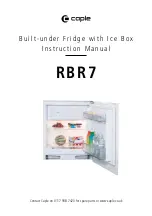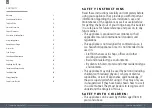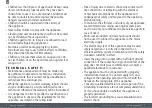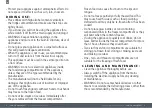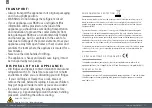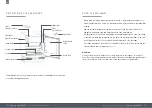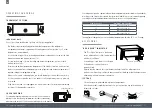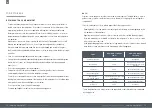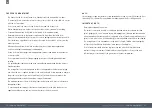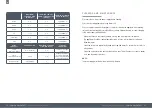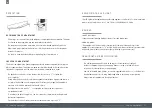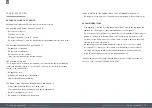
18
19
Instruction manual RBR7
Instruction manual RBR7
Please keep this instruction manual for future reference
Please keep this instruction manual for future reference
F O O D S TO R A G E
R E F R I G E R ATO R C O M PA RT M E N T
› To reduce humidity and avoid the consequent formation of frost, always store liquids in
sealed containers in the refrigerator. Frost tends to concentrate in the coldest parts of the
evaporating liquid and, in time, your appliance will require more frequent defrosting.
› Never place warm food in the refrigerator. Warm food should be allowed to cool at room
temperature and should be arranged to ensure adequate air circulation in the refrigerator
compartment.
› Make sure no items are in direct contact with the rear wall of the appliance as frost will
develop and packaging will stick to it. Do not open the refrigerator door frequently.
› We recommend that meat and clean fish are loosely wrapped and stored on the glass
shelf just above the vegetable bin where the air is cooler, as this provides the best storage
conditions.
› Store loose fruit and vegetable items in the crisper containers.
› Storing fruit and vegetables separately helps prevent ethylene-sensitive vegetables (green
leaves, broccoli, carrot, etc.) being affected by ethylene-releaser fruits (banana, peach,
apricot, etc.).
› Do not put wet vegetables into the refrigerator.
› Storage time for all food products depends on the initial quality of the food and an
uninterrupted refrigeration cycle before refrigerator storage.
› To avoid cross-contamination do not store meat products with fruit and vegetables. Water
leaking from meat may contaminate other products in the refrigerator. You should package
meat products and clean any leakages on the shelves.
› Do not put food in front of the air flow passage.
› Consume packaged foods before the recommended expiry date.
NOTE:
Potatoes, onions and garlic should not be stored in the refrigerator. The table below is a quick
guide to show you the most efficient way to store the major food groups in your refrigerator
compartment.
To avoid contamination of food, please respect the following instructions:
› Opening the door for long periods can cause significant increase of the temperature in the
compartments of the appliance.
› Regularly clean surfaces that can come in contact with food accessible drainage systems.
› Store raw meat and fish in suitable containers in the refrigerator, so that it is not in contact
with or drips onto other food.
› If the refrigerating appliance is left empty for long periods, switch off, defrost, clean, dry and
leave the door open to prevent mould developing within the appliance.
F O O D
M A X I M U M S TO R AG E
T I M E *
H OW A N D W H E R E
TO S TO R E
Vegetables and fruits
1 week
Vegetable bin
Meat and fish
2-3 days
Wrap in plastic foil, bags, or in a
meat container and store on the
glass shelf
Fresh cheese
3-4 days
On the designated door shelf
Butter and margarine
1 week
On the designated door shelf
Bottled products
e.g. milk and yoghurt
Until the expiry date recommended
by the producer
On the designated door shelf
Eggs
1 month
On the designated egg tray
Cooked food
2 days
All shelves
* These are guidelines only, always refer to the expiry date, or best before date recommended
by the producer.

